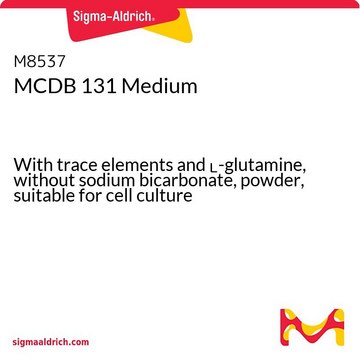M6770
MCDB 201 Medium
With trace elements, L-glutamine and 30 mM HEPES, powder, suitable for cell culture
Sinónimos:
MCDB medium
Iniciar sesiónpara Ver la Fijación de precios por contrato y de la organización
About This Item
Código UNSPSC:
41161501
NACRES:
NA.75
Productos recomendados
Nivel de calidad
Formulario
powder
técnicas
cell culture | mammalian: suitable
componentes
HEPES: 7.149 g/L (30mM)
glucose: 1.441 g/L (Dextro)
phenol red: 0.001242 g/L
sodium pyruvate: 0.055 g/L
L-glutamine: 0.14615 g/L
Condiciones de envío
ambient
temp. de almacenamiento
2-8°C
Descripción general
MCDB 201 medium is a modified Ham′s nutrient mixture F-12 that is synthesized for the clonal growth of chicken embryo fibroblasts.
Aplicación
MCDB 201 Medium has been used as a component of:
- the hepatic differentiation medium to culture pluripotent stem cells,
- epididymal growth medium for culturing of preadipocytes,
- Dulbecco′s Modified Eagle Medium (DMEM)/F12 for culturing of human umbilical cord mesenchymal stem cells
Cantidad
Formulated to contain 17.7 grams of powder per liter of medium.
suplemento
Referencia del producto
Descripción
Precios
Código de clase de almacenamiento
11 - Combustible Solids
Clase de riesgo para el agua (WGK)
WGK 1
Punto de inflamabilidad (°F)
Not applicable
Punto de inflamabilidad (°C)
Not applicable
Elija entre una de las versiones más recientes:
¿Ya tiene este producto?
Encuentre la documentación para los productos que ha comprado recientemente en la Biblioteca de documentos.
Los clientes también vieron
Jeff Ishibashi et al.
Molecular and cellular biology, 32(12), 2289-2299 (2012-04-05)
Fibroblastic preadipocyte cells are recruited to differentiate into new adipocytes during the formation and hyperplastic growth of white adipose tissue. Peroxisome proliferator-activated receptor γ (PPARγ), the master regulator of adipogenesis, is expressed at low levels in preadipocytes, and its levels
Baris Ulum et al.
Journal of cellular physiology, 233(11), 8429-8436 (2018-05-26)
Bone marrow mesenchymal stem cells (BM-MSCs) are promising candidates for regenerative medicine purposes. The effect of obesity on the function of BM-MSCs is currently unknown. Here, we assessed how obesity affects the function of BM-MSCs and the role of endoplasmic
Philip Roelandt et al.
Methods in molecular biology (Clifton, N.J.), 997, 141-147 (2013-04-03)
Differentiation of human stem cells to hepatocytes is crucial for industrial applications as well as to develop new therapeutic strategies for liver disease. The protocol described here, using sequentially growth factors known to play a role in liver embryonic development
Philip Roelandt et al.
PloS one, 5(8), e12101-e12101 (2010-08-17)
Stem cell-derived hepatocytes may be an alternative cell source to treat liver diseases or to be used for pharmacological purposes. We developed a protocol that mimics mammalian liver development, to differentiate cells with pluripotent characteristics to hepatocyte-like cells. The protocol
C-S Bao et al.
European review for medical and pharmacological sciences, 22(19), 6436-6447 (2018-10-20)
This research aimed to investigate the therapeutic effects of transplanted human umbilical cord mesenchymal stem cells (hUCMSCs) on spinal cord injury in mice and to explore its molecular mechanism. Spinal cord injury model in C57BL/6J mice was established. On the
Nuestro equipo de científicos tiene experiencia en todas las áreas de investigación: Ciencias de la vida, Ciencia de los materiales, Síntesis química, Cromatografía, Analítica y muchas otras.
Póngase en contacto con el Servicio técnico









